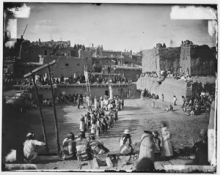Article
An architectural feature found in the built environments of many cultures around the world, plazas are open spaces for public functions around which structures form an almost amphitheater-like setting. In Native American traditions in the U.S. Southwest, plazas are created by the terraced clustering of a pueblo community around usually one of several open spaces significant to the community. The early Spanish explorers in the region believed that they recognized in these open spaces the plazas of their own secular and religious built environments, and therefore called them plazas, which is the term still in use today. Puebloan plazas have social, secular, and spiritual functions, and are oriented in space to accommodate seasonal and diurnal solar patterns, as well as the ceremonial needs of a linked system of spiritual fraternities. Plazas are often associated with prominent kiva societies and ceremonies; because of this, the Catholic church appropriated Puebloan plazas as locations upon which to site their mission compounds as they evangelized the northern perimeters of New Spain in the Americas during the sixteenth, seventeenth , and eighteenth centuries. Over time, Puebloan plazas came to accommodate both indigenous and Catholic practices, revealing the syncretic use of space still in practice today in many Pueblo communities.
"Dancers in the plaza at Zuni Pueblo, circa 1890" by John K. Hillers is licensed under Public Domain.
Manuscripts
A07 The Dark Wind (04-06), p. 173
A07 The Dark Wind (04-06), p. 174
A07 The Dark Wind (04-06), p. 239
A07 The Dark Wind (04-06), p. 242
A07 The Dark Wind (04-06), p. 243
A07 The Dark Wind (04-06), p. 244
A07 The Dark Wind (04-06), p. 245
A07 The Dark Wind (04-06), p. 246
A07 The Dark Wind (04-06), p. 248
A07 The Dark Wind (04-06), p. 249
A07 The Dark Wind (04-06), p. 250
A07 The Dark Wind (04-06), p. 252

